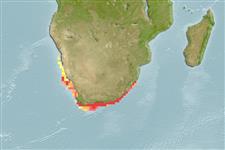Elasmobranchii (haaien en roggen) (sharks and rays) >
Torpediniformes (Electric rays) >
Narkidae (Sleeper rays)
Etymology: Narke: Greek, narke = numbness (Ref. 45335).
More on author: Gmelin.
Environment: milieu / climate zone / depth range / distribution range
Ecologie
marien demersaal; diepte 20 - 183 m (Ref. 6589). Subtropical; 23°S - 36°S, 13°E - 32°E (Ref. 114953)
Southeast Atlantic: Cape of Good Hope to central Natal, South Africa. Possibly occurring in Namibia, Mozambique and Madagascar (Ref. 5578, Ref. 114953).
Grootte / Gewicht / Leeftijd
Maturity: Lm ? range ? - ? cm
Max length : 38.0 cm TL mannelijk / geslacht onbekend; (Ref. 5578)
Korte beschrijving
Morfologie | Morfometrie
Small ray with an almost circular disc and an elongated caudal fin (Ref. 5578). Yellowish-brown above with yellowish patches on upper tail, yellow with brown margins below (Ref. 5578).
Occurs offshore on the shelf; also common on sandy and muddy bottoms at 20-115 m (Ref. 5578). Feeds mainly on polychaetes (Ref. 5578). Males reaches maturity at 18-23 cm TL, females at ca. 23 cm TL (Ref. 114953). Capable of giving a powerful shock (Ref. 5578). Incidental catch of trawlers (Ref. 5578). It is parasitised by the monogenean Electrocotyle whittingtoni in the gills (Ref. 124060).
Levenscyclus en paargedrag
Maturiteit | Voortplanting | Paaien | Eieren | Fecunditeit | Larven
Compagno, L.J.V., 1986. Narkidae. p. 113-114. In M.M. Smith and P.C. Heemstra (eds.) Smiths' sea fishes. Springer-Verlag, Berlin. (Ref. 6589)
Status op de Rode Lijst van het IUCN (Ref. 130435)
Gebruik door de mens
Aquarium: Commercieel
Meer informatie
Leeftijd/GrootteGroeiLengte-gewichtLengte-lengteLengtefrequentiesMorfometrieMorfologieLarvenLarvale populatiedynamiekRekruteringAbundantieBRUVS
ReferentiesAquacultuurAquacultuurprofielKweeklijnenGeneticaElectrophoresesErfelijkheidZiektesVerwerkingNutrientsMassaconversie
Tools
Speciale rapporten
Download XML
Internetbronnen
Estimates based on models
Preferred temperature (Ref.
123201): 12.7 - 20.6, mean 16 °C (based on 22 cells).
Fylogenetische diversiteitsindex (Ref.
82804): PD
50 = 0.6252 [Uniqueness, from 0.5 = low to 2.0 = high].
Bayesian length-weight: a=0.01000 (0.00244 - 0.04107), b=3.04 (2.81 - 3.27), in cm total length, based on all LWR estimates for this body shape (Ref.
93245).
Trofisch niveau (Ref.
69278): 3.1 ±0.26 se; based on food items.
Weerstandsvermogen (Ref.
120179): laag, minimale populatieverdubbelingstijd 4,5-14 jaar (Assuming fecundity<100).
Fishing Vulnerability (Ref.
59153): Low to moderate vulnerability (28 of 100).
